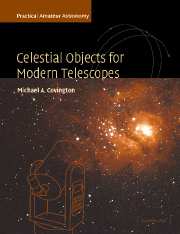Book contents
- Frontmatter
- Contents
- Preface
- Part I Amateur astronomy
- 1 Using this book effectively
- 2 Observing sites and conditions
- 3 The Moon, the Sun, and eclipses
- 4 The planets
- 5 Comets, asteroids (minor planets), and artificial satellites
- 6 Constellations
- 7 Stars – identification, nomenclature, and maps
- 8 Stars – physical properties
- 9 Double and multiple stars
- 10 Variable stars
- 11 Clusters, nebulae, and galaxies
- Part II 200 interesting stars and deep-sky objects
- Appendices
- Index
3 - The Moon, the Sun, and eclipses
Published online by Cambridge University Press: 22 September 2009
- Frontmatter
- Contents
- Preface
- Part I Amateur astronomy
- 1 Using this book effectively
- 2 Observing sites and conditions
- 3 The Moon, the Sun, and eclipses
- 4 The planets
- 5 Comets, asteroids (minor planets), and artificial satellites
- 6 Constellations
- 7 Stars – identification, nomenclature, and maps
- 8 Stars – physical properties
- 9 Double and multiple stars
- 10 Variable stars
- 11 Clusters, nebulae, and galaxies
- Part II 200 interesting stars and deep-sky objects
- Appendices
- Index
Summary
The Moon
Phases of the Moon
We often make jokes about activities that depend on the phases of the Moon, but amateur astronomy really does. When the Moon is high in the sky, especially if it is full or nearly full, you can't see faint stars, nebulae, or galaxies. Conversely, if you want to observe the Moon you need to know when and where it is going to appear.
Accordingly, all astronomical observers need to keep track of the phases of the moon. Figure 3.1 summarizes the whole cycle. The Casio “Forester” wristwatch, marketed to hikers and fishermen, keeps track of the cycle for you.
The Moon stays close to the ecliptic, though not precisely on it, and moves eastward, making a full circle relative to the stars every 27.32 days (one sidereal month). This means that it moves its own apparent width (half a degree) in slightly less than an hour. You can watch this happen when the Moon passes near a bright star.
The cycle of phases, or synodic month, takes 29.53 days. This is longer than the sidereal month because the Sun and Moon are moving in the same direction; the Moon has to move more than a full circle in order to catch up.
- Type
- Chapter
- Information
- Celestial Objects for Modern TelescopesPractical Amateur Astronomy Volume 2, pp. 23 - 41Publisher: Cambridge University PressPrint publication year: 2002

